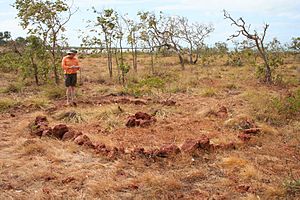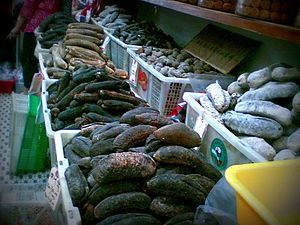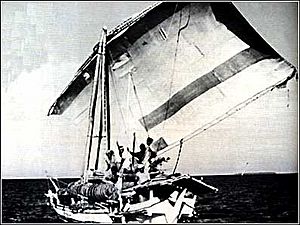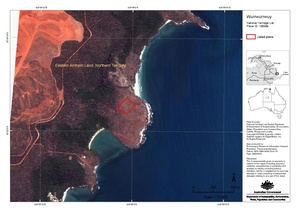Wurrwurrwuy stone arrangements facts for kids
Quick facts for kids Wurrwurrwuy stone arrangements |
|
|---|---|

Stone arrangement, 2005
|
|
| Location | Yirrkala, Northern Territory, Australia |
| Official name: Wurrwurrwuy | |
| Type | Listed place (Indigenous) |
| Designated | 9 August 2013 |
| Reference no. | 106088 |
| Lua error in Module:Location_map at line 420: attempt to index field 'wikibase' (a nil value). | |
The Wurrwurrwuy stone arrangements are an amazing ancient site in Yirrkala, Northern Territory, Australia. It's a special place where Indigenous people created pictures using stones. These stone pictures tell important stories about the past, especially about how Aboriginal people met and traded with visitors from other countries long ago. Wurrwurrwuy is so important that it was added to the Northern Territory Heritage Register in 2007 and the Australian National Heritage List in 2013, recognizing its value to Australia's history.
Contents
A Look Back in Time
This section explores the history of Wurrwurrwuy and the people who visited this part of Australia.
Early Discoveries by Explorers
In the early 1800s, a famous explorer named Matthew Flinders sailed around Australia. When he explored the coast of the Gulf of Carpentaria, he found interesting clues. He saw bamboo frames, stone fireplaces, pieces of cloth, and tree stumps cut with metal axes. These things showed that people from other countries had visited this area.
On February 16, 1803, Flinders met a group of boats called Macassan praus. These boats were anchored near the English Company Islands. He learned from a captain named Pobassoo that Macassan praus came to northern Australia every year. They used the north-west monsoon winds to travel. Their main goal was to collect and dry trepang, also known as sea cucumbers. They would then sell these dried sea cucumbers to people in China.
Macassan Visitors and Aboriginal People
Flinders' meeting with Pobassoo was the first time anyone officially wrote about the "trepang industry" in northern Australia. Macassans likely started visiting the coast before 1650. However, catching and processing trepang for the Chinese market probably became a big business around 1750. The Macassans stopped being involved in this industry in 1906. This happened when the South Australian Government, which managed the Northern Territory back then, limited fishing licenses to only local boats.
We can still find signs of the Macassan trepang industry today. These include tamarind trees (which are not native to Australia), places where trepang was processed, and pictures of Macassan praus in rock art. Trepang processing sites are found along the Kimberley coast and the coasts of Arnhem Land and Groote Eylandt. Pictures of praus are common in the rock art of Arnhem Land and nearby islands. These clues, along with stories passed down by Aboriginal people, show how Macassans and Aboriginal groups interacted.
How Aboriginal Life Changed
Aboriginal people in Arnhem Land began to use some Macassan tools and items. They adopted dugout canoes and iron. This changed their way of life, especially how they used the ocean for food. For example, many dugong and turtle bones are found in ancient rubbish heaps (called middens) from that time. This shows that people were hunting more sea animals. There were also changes in how Aboriginal people used their land and how they traded with other groups.
Aboriginal people in Arnhem Land also kept the memory of Macassans alive in their culture. Macassans and their journeys are important in some ceremonies and song cycles. Some songs even include parts of Muslim prayers. Old stories also tell of Aboriginal people working for Macassans at trepang sites. Some even traveled on praus to the Celebes (now part of Indonesia) and even further. The close bond between Macassans and Aboriginal people is clear in the many Macassan words found in Aboriginal languages in Arnhem Land. These words include names for different parts of praus and their rigging (the ropes and cables).
The Stone Pictures at Wurrwurrwuy
The stone pictures at Wurrwurrwuy are a special part of the story of Macassan and Aboriginal interactions in Arnhem Land. These pictures are located in the land of the Lamomirri clan. After the last Lamomirri man responsible for the site passed away, the pictures were looked after by the Gumatj clan.
A father and son, Yumbul and Dhatalamirri, created these stone pictures. They probably made them in the second half of the 1800s. Stories from 1967 say that Yumbul, possibly with help from others, made the first pictures. Later, his second son, Dhatalamirri, took care of the site and added more pictures.
The stone pictures made by Yumbul and Dhatalamirri show many things related to the Macassan visits. They depict Macassan praus (boats), canoes, houses with many rooms, fireplaces for boiling trepang, and drying houses for the trepang. There's even a house for storing wood and stones used to sharpen iron knives. Some pictures of an Aboriginal fish trap and Aboriginal homes might have been made by other people.
When researchers studied the site in 1967, two Aboriginal men, Munggurrawuy and Mawalan, explained the pictures. They showed how the different parts of the praus in the pictures represented specific areas. These included the crew's sleeping area, the kitchen, the eating space, the storage area, and the water tank. They also knew the Macassan names for parts of the praus, like the rudder, bowsprit, and the tripod mast with its sail. These pictures prove that the Yolngu people (a group of Aboriginal people) visited trepang sites and spent enough time on praus to learn all about them. This matches historical records that show Aboriginal people traveled on praus to the Celebes.
The people looking after the site told researchers that Wurrwurrwuy was a gift from the past. It wasn't a sacred place, but it was very useful. It helped younger men learn about the Macassan way of life and how they came to collect trepang. These stone pictures are a lasting reminder of the Yolngu people's knowledge about this important part of their history.
What Wurrwurrwuy Looks Like
The Wurrwurrwuy stone arrangements cover an area of about 1.41 hectares. This is about 10 kilometers south-east of Yirrkala in Eastern Arnhem Land. The area is bordered by a small creek to the north, a thick coastal forest to the west, and the sea to the east and south. The land where the stones are found has low grass and small shrubs.
The stone pictures themselves cover an area of about 80 meters by 70 meters. They are grouped into three main sections, with a few other features nearby. The pictures at the southern end mostly show Macassan subjects using simple outlines. The northern group also shows Macassan subjects, but in a different style. Here, stones of different sizes are used to make parts of the pictures stand out more. The western group has a mix of both Macassan and Aboriginal subjects.
How the Site is Kept Safe
When the site was first recorded in the 1960s, there was some minor damage from buffalo, especially at the southern end. However, there has been no further damage since then. The site has been fenced to protect it, and paths and signs have been added to help visitors understand it. The Dhimurru Corporation Aboriginal Rangers help maintain and look after this special place.
The stone pictures at Wurrwurrwuy are very important to Australia. They are a rare example of stones arranged to show everyday things, not just sacred or ceremonial subjects. The pictures show many different things, including Aboriginal camps, fish traps, and images related to the Macassan trepang industry. These include praus, canoes, stone fireplaces for boiling trepang, and Macassan houses. The pictures of praus at Wurrwurrwuy are unique because they show the inside parts of the boats. This is rare in Aboriginal art. The people who made these stone pictures must have learned about the inside of the praus by visiting or traveling on them.
Wurrwurrwuy stone arrangements was added to the Australian National Heritage List on August 9, 2013, because it met certain important standards.
Criterion B: Rarity The stone pictures at Wurrwurrwuy are incredibly valuable because they are a rare example of stones used to show everyday objects and activities. Usually, arranged stones are linked to ceremonies or sacred beliefs. It's also rare to see such detailed pictures of the inside of praus. The artists gained this knowledge by visiting or traveling on these boats.




